Situational awareness: Animal incidents
Control Measure Knowledge
This control measure should be read in conjunction with Incident command – Situational awareness
Whether the animal involved is a companion animal, a captive animal or wildlife, will help to inform decision-making.
Gathering information about the animal or animals involved in the incident will help to inform the fire and rescue service level of response. Information sources include:
- The caller contacting fire control – this could be a member of the public, an animal welfare charity or another organisation
- The animal itself, as identification markers or its location may help to identify the owner
- The owner of the animal, who may or may not be at the scene of the incident
- Site-Specific Risk Information (SSRI), for locations such as:
- Large farms
- Livestock markets
- Abattoirs
- Racecourses (horse or dog)
- Zoos
- Laboratories
- Veterinary colleges
- Large animal rescue centres
- Location Notices for premises such as:
- Small farms
- Veterinary clinics
- Boarding catteries and kennels
- Premises that contain dangerous animals
- Stables
- Circuses
- Animal fairs
Caller information
Information gathered from the caller should include:
- The environment that the animal is in, such as:
- At height or depth
- In an enclosed space
- In a building or structure
- In a mode of transport
- On ice or unstable ground
- For an animal in water whether the water is:
- Still or moving
- Above or below knee height
- Inland or coastal
- If the animal is trapped, the nature of entrapment or entanglement
- The number of animals involved
- The species of animal
- Whether it is a companion animal, a captive animal or wildlife
- The size of the animal – whether it is larger or heavier than an adult human
- The physical condition of the animal
- The behaviour or the animal
The information gathered should also include:
- Whether the owner of the animal is at the scene of the incident, or if not, whether they are contactable
- Whether any members of the public are:
- Involved with the incident, for example, attempting to rescue the animal
- Trapped by the animal
- At risk of harm from the animal
- Whether an animal specialist has been contacted or is en route to the incident
Animal identification
Identification markers on or with the animal could include:
- Microchips
- Collar tags
- Branding
- Tattoos
- Ear tags
- Pet passports, information about a nominated pet guardian, or other documents
Owner information
The person who owns an animal should always be regarded as being responsible for it. However, another person or organisation can be responsible for the animal on a temporary basis; this could include a fire and rescue service. For companion or captive animals, it is beneficial to identify the owner for some decisions about the animal that will need to be made.
Information gathered from the owner should include:
- Pre-existing medical conditions, including any diseases, of the animal
- The age of the animal
- The animal’s usual behaviour, although this may not reflect its behaviour when distressed
- Triggers for aggression
- Restraint methods the animal is used to
Notifiable diseases
There is a legal obligation to report the presence or suspicion of a notifiable disease in animals. Refer to GOV.UK: A collection of guides to notifiable diseases in animals for further information.
Notifiable animal diseases can be reported 24 hours a day, 7 days a week by:
- Calling 03000 200 301 (for England)
- Calling 03003 038 268 (for Wales)
- Contacting APHA Field Services (for Scotland)
- Calling 0300 200 7840 (for Northern Ireland)
